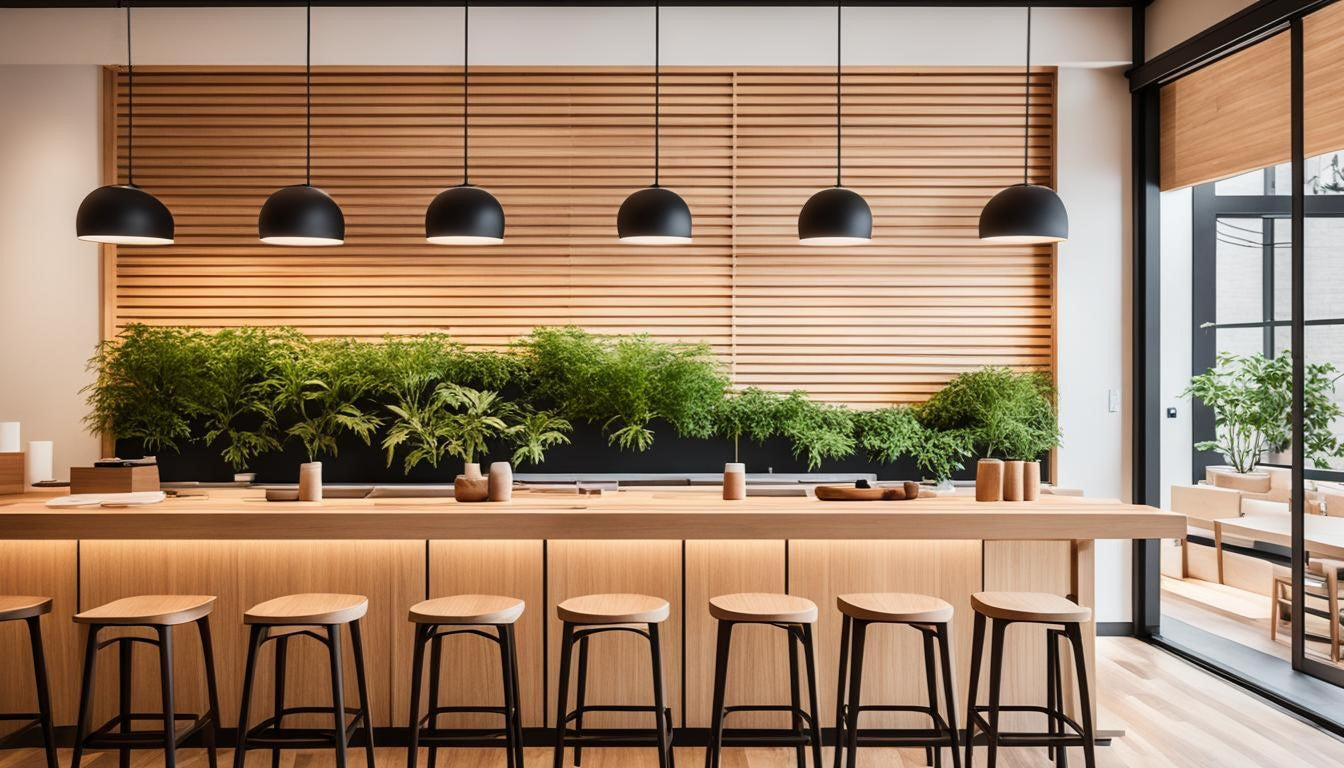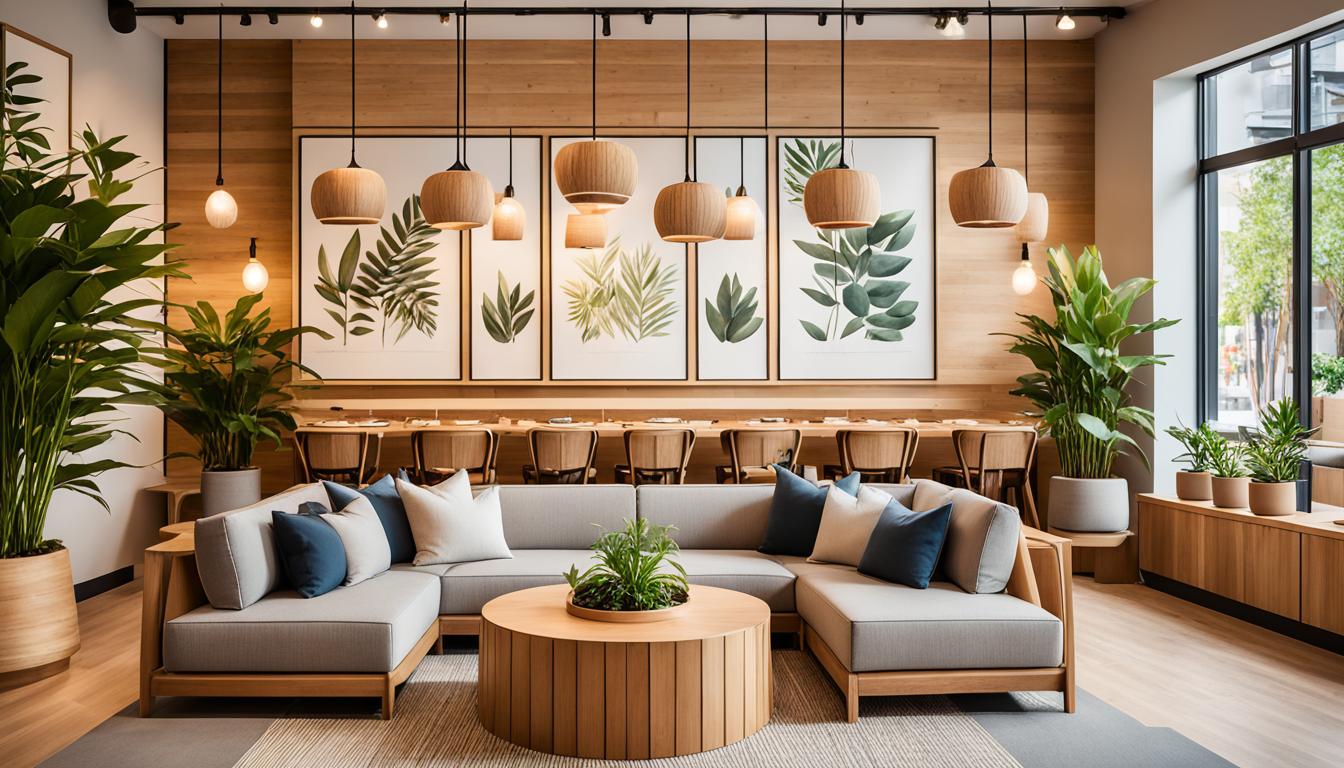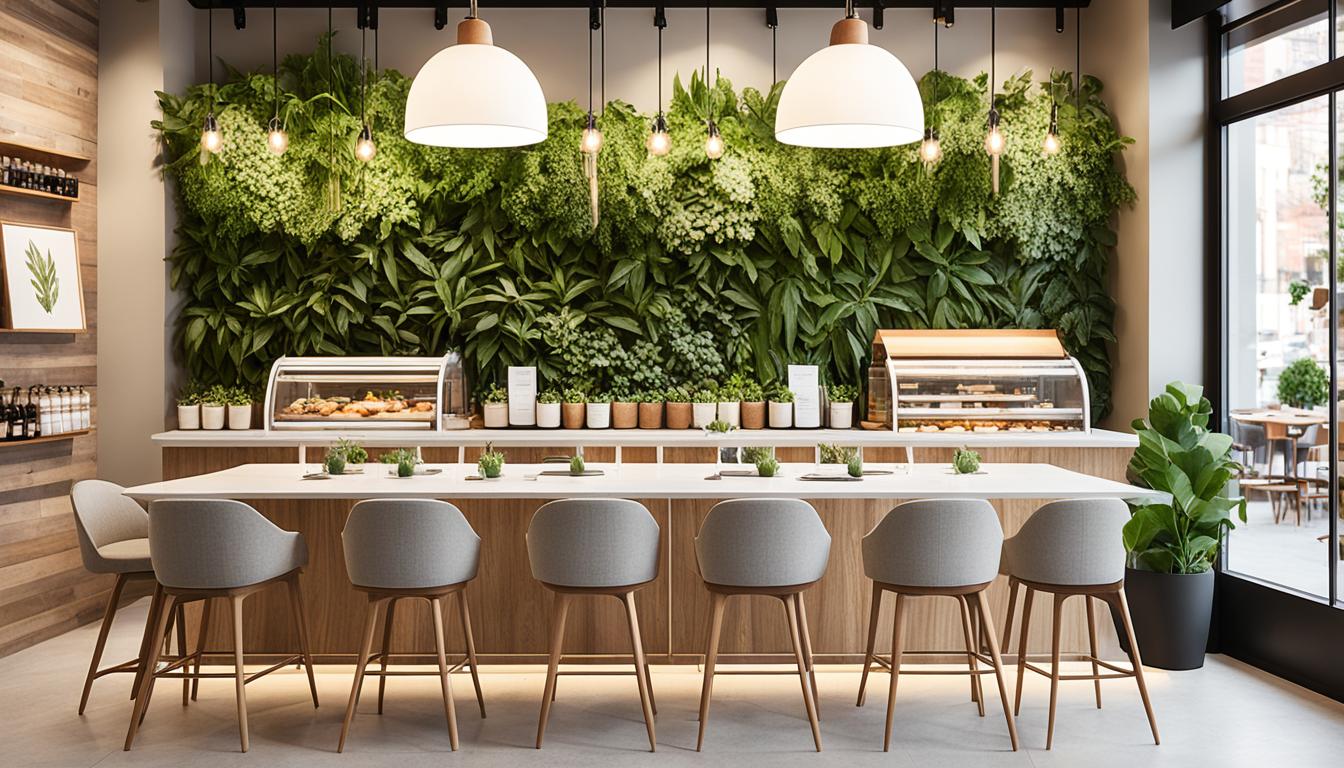✅ FREE SHIPPING in the USA ✅ 30-DAY MONEY BACK GUARANTEE
✅ FREE SHIPPING in the USA ✅ 30-DAY MONEY BACK GUARANTEE
Welcome to our guide on Japandi cafe ideas, where we explore the seamless fusion of zen and cozy vibes in cafe design.
Japandi cafes have gained popularity for their unique blend of Japanese and Scandinavian aesthetics, creating a serene and inviting atmosphere for customers.
In this article, we will delve into the core elements of Japandi design, discuss strategies for incorporating a serene ambiance, explore fusion furniture choices, and highlight the importance of neutral color palettes.
Join us as we unravel the secrets behind crafting a minimalist and cozy cafe interior that embraces the Japandi ethos.

Japandi design is a unique blend of Japanese and Scandinavian styles, combining the simplicity and functionality of Scandinavian design with the elegance and harmony of Japanese aesthetics.
It is a popular design trend that has taken the interior design world by storm, especially in the realm of cafes.
The history of Japandi aesthetics can be traced back to the mid-20th century, when the principles of Scandinavian design and Japanese aesthetics started to intersect.
Both styles emphasized minimalism, natural elements, and functionality, albeit in their own distinct ways.
Scandinavian design focused on creating functional, clean-lined furniture and spaces, with an emphasis on light colors and natural materials.
It aimed to create interiors that were simple, cozy, and welcoming.
Japanese aesthetics, on the other hand, emphasized the principles of wabi-sabi, which celebrated imperfection, simplicity, and the beauty of natural materials.
It sought to create a sense of tranquility, balance, and harmony in spaces.
Over time, designers and homeowners started to realize that these two styles complemented each other beautifully.
This led to the emergence of Japandi aesthetics, which bring together the best elements of both Japanese and Scandinavian design.
The core elements of Japandi design revolve around simplicity, functionality, natural materials, and a serene color palette.
These elements work together to create a harmonious and peaceful atmosphere in Japandi cafes.
Key features of Japandi design include:
The result of these core elements is a harmonious blend of two distinct design philosophies, creating a serene and welcoming environment that is loved by cafe-goers worldwide.

| Japanese Design | Scandinavian Design |
|---|---|
| Focus on elegance and harmony | Emphasis on simplicity and functionality |
| Use of natural materials like bamboo and paper | Utilization of organic materials like wood and leather |
| Appreciation for imperfection and natural beauty | Preference for clean lines and minimalistic forms |
| Ethos of tranquility and balance | Desire to create cozy and welcoming spaces |
In a Japandi cafe, creating a serene and calming ambiance is crucial to delivering an exceptional experience for customers.
The design of the cafe plays a significant role in establishing a peaceful atmosphere that promotes relaxation and contentment.
When designing a Japandi cafe, several strategies can be employed to cultivate a calming cafe environment:
Natural light and open spaces are key elements in crafting a serene cafe ambiance.
Here are some techniques to maximize the presence of natural light and create an open and spacious atmosphere:
By implementing these strategies and techniques, a Japandi cafe can successfully incorporate a serene cafe ambiance through thoughtful design choices, natural elements, and an emphasis on openness and comfort.
Japandi cafes are known for their unique blend of Japanese and Scandinavian design elements, and this fusion extends to their choice of furniture.
In creating a Japandi inspired cafe, it's important to select seating options that embody the minimalist aesthetic while incorporating organic shapes and natural materials.
When it comes to seating, consider minimalist chairs and stools that feature clean lines and simple designs.
Opt for furniture made from natural materials such as wood, rattan, or bamboo to add warmth and a touch of nature to the cafe environment.

One popular choice for Japandi cafes is the use of low seating, such as floor cushions or low chairs.
These seating options create a more relaxed and informal atmosphere, allowing customers to immerse themselves in the serene ambiance of the cafe.
Another consideration is the incorporation of unique and eye-catching furniture pieces that showcase the fusion of Japanese and Scandinavian design.
Look for furniture with organic shapes, minimalist yet distinctive silhouettes, and subtle details that reflect the essence of Japandi aesthetics.
By selecting fusion furniture that combines elements of both Japanese and Scandinavian design, Japandi cafes can create a truly unique and captivating space that resonates with customers seeking a serene and harmonious experience.
In Japandi design, neutral color palettes play a pivotal role in creating a serene and calming atmosphere in cafes.
These subtle, understated hues contribute to the overall sense of harmony and tranquility that define the Japandi aesthetic.
By strategically selecting harmonious color schemes, cafe owners can establish a peaceful ambiance that enhances the overall dining experience for their customers.
When choosing color schemes for a Japandi cafe, it is important to consider the principles of color psychology.
Colors have the power to evoke specific emotions and moods, so selecting the right combination is crucial.
In the context of Japandi design, earthy tones such as shades of beige, brown, and gray are commonly used.
These neutral colors create a sense of grounding and tranquility, reflecting the influence of both Japanese and Scandinavian design.
Complementing the neutral base with accents of muted pastels or soft blues can further enhance the harmonious atmosphere of the cafe.
These gentle pops of color add visual interest while maintaining the overall serenity of the space.
It is essential to strike a balance between the calming neutral tones and the subtle accent colors to achieve the desired effect.
Color can be utilized strategically to influence the atmosphere of a Japandi cafe.
For instance, warmer tones like light shades of beige or subtle hints of peach can create a cozy and welcoming ambiance.
These colors evoke a sense of comfort and relaxation, making customers feel right at home in the cafe.
On the other hand, cooler tones like soft blues or subdued greens can promote a tranquil and refreshing atmosphere.
These colors are reminiscent of natural elements such as the sea or fresh foliage, further immersing customers in the serene ambiance of the Japandi cafe.
By understanding the psychological effects of different colors, cafe owners can intentionally use color to shape the overall mood and atmosphere of their space.
Whether aiming for a warm and inviting environment or a calm and rejuvenating oasis, the choice of color palette can greatly contribute to the desired ambiance.

At the heart of Japandi design philosophy is the seamless integration of minimalist aesthetics with functional elements.
To create a truly harmonious and efficient cafe space, we must prioritize practicality alongside sleek and minimalist design choices.
One key aspect of integrating minimalist cafe design is the layout.
By optimizing the flow of the cafe, we can improve efficiency and enhance the overall customer experience.
Consider the placement of key areas such as the counter, seating, and service stations to ensure smooth movement and minimize congestion.
When selecting furniture for a Japandi-inspired cafe, practicality should be the guiding principle.
Opt for simple yet comfortable seating that aligns with the minimalist aesthetic. Choose materials that are durable and easy to clean, allowing for effortless maintenance.

Incorporating storage solutions is also essential to maintaining a clutter-free environment.
Utilize hidden shelving units or wall-mounted hooks to keep supplies and equipment organized and within easy reach, contributing to a clean and streamlined cafe space.
Lastly, consider the functionality of fixtures and fittings. Opt for energy-efficient lighting that provides ample illumination, enhances the ambiance, and reduces energy consumption.
The choice of tableware, utensils, and equipment should prioritize practicality and ease of use, ensuring a seamless experience for both staff and customers.
By integrating minimalist design principles with functional elements, we can create a Japandi-inspired cafe that not only exudes tranquility but also offers a practical and efficient environment for both customers and staff.
The menu presentation in a Japandi cafe is an essential element that should seamlessly align with the overall design aesthetic.
Every detail matters in creating a cohesive and visually appealing menu that reflects the serene and minimalist ambiance of a Japandi cafe.
In this section, we will explore menu design tips that can elevate the dining experience and leave a lasting impression on customers.
Alongside the menu design, the culinary selections in a Japandi cafe should align with the overall ethos of simplicity, balance, and natural ingredients.
Emphasize the use of fresh, locally sourced ingredients and combine flavors inspired by Japanese and Scandinavian cuisine.
Offer a variety of dishes that highlight the delicate flavors and culinary techniques of both cultures.
From light and nourishing bowls to thoughtfully crafted pastries, curate a menu that reflects the Japandi ethos and offers a unique dining experience.
Crafting the perfect menu presentation in a Japandi cafe involves thoughtful consideration of design elements, typography, and culinary selections.
By embracing minimalist aesthetics and incorporating natural materials, you can enhance the overall dining experience and create a harmonious fusion of design and gastronomy.
Lighting is a crucial element in creating the desired atmosphere in a Japandi cafe.
It not only illuminates the space but also enhances the overall aesthetic of the interior.
In this section, we will explore creative lighting solutions that can elevate Japandi interiors, providing a harmonious blend of Japanese and Scandinavian influences.
By carefully choosing light fixtures that reflect the Scandi-Japanese style, we can create a modern and inviting cafe environment.
When selecting light fixtures for a Japandi cafe, it's essential to choose those that embrace the Scandi-Japanese influence.
Opt for fixtures that feature clean lines, minimalistic designs, and natural materials such as wood and metal.
Japanese lantern-inspired pendant lights or Scandinavian-inspired ceiling fixtures can add a touch of elegance to the space.
By layering different types of lighting, such as ambient, task, and accent lighting, you can create a dynamic and visually appealing atmosphere.
A Japandi cafe is not limited to creating a serene and cozy atmosphere indoors.
By incorporating Japandi landscaping in the outdoor spaces, the harmonious design principles can be extended beyond the cafe's interior, creating a seamless and tranquil experience for visitors.
Outdoor areas provide an opportunity to connect with nature and continue the Japandi aesthetic in a refreshing and natural environment.
When designing the outdoor spaces of a Japandi cafe, it is essential to maintain the core elements of Japandi design that reflect simplicity, minimalism, and natural harmony.
The focus should be on creating a peaceful retreat where customers can relax and enjoy the serene ambiance.
One way to achieve this is by incorporating natural materials such as wood, stone, and bamboo into the outdoor landscaping.
These materials not only blend seamlessly with the Japandi aesthetic but also create a connection with the surrounding natural environment.
A Zen garden can be a beautiful addition to the outdoor space, reflecting the Zen philosophy of Japanese gardens and adding a sense of tranquility.
With carefully arranged rocks, gravel, and strategically placed plants, a Zen garden can evoke a sense of peace and serenity.
Additionally, integrating water features such as fountains or small ponds can bring a soothing element to the outdoor area, adding the gentle sound of flowing water to enhance the overall ambiance.
To achieve a seamless and cohesive design, it is important to bridge the indoor and outdoor elements in a Japandi cafe.
This can be done by using similar materials, colors, and design details in both areas.
For example, incorporating sliding glass doors or large windows that open up the indoor space to the outdoor area can create a seamless connection.
The use of similar natural materials for flooring or wall treatments, both indoors and outdoors, can further enhance this connection and create a sense of harmony.
Strategically placed plants and greenery can also help blur the boundaries between the indoor and outdoor spaces, blending them together seamlessly.
Indoor plants can be strategically positioned near windows or glass doors to create a visual flow from the interior to the exterior.
| Benefits of Japandi Landscaping in Outdoor Spaces | Examples |
|---|---|
|
|
Now that you have read the above article, maybe you still have a couple of questions on this topic, so we will answer these questions below.
A Japandi cafe is a cafe that combines the calming aesthetics of Japanese and Scandinavian design to create a serene and cozy atmosphere for customers.
It focuses on minimalism, natural elements, and functionality, blending the best of both cultures to create a unique and inviting space.
To create a calming cafe environment, you can use strategies such as incorporating natural materials, implementing minimalist decor, ensuring comfortable seating, maximizing natural light, and creating open and spacious layouts.
These elements contribute to a relaxing and peaceful atmosphere.
Lighting plays a crucial role in creating the desired atmosphere in a Japandi cafe.
Choosing light fixtures that reflect Scandi-japanese influence and exploring the role of lighting in creating modern cafe aesthetics can enhance the overall ambiance and highlight specific design elements.
To achieve the perfect Japandi vibe, consider partnering with local artisans or sourcing unique pieces from specialty stores like Mojo Boutique, that offer Scandinavian and Japanese-inspired furniture and decor.
By paying attention to the fusion cafe interior, adhering to the Scandi-Japanese cafe concept, and choosing the right furniture and decor items, you can create a cafe that stands out from the crowd and captures the essence of Japandi.
In conclusion, embracing the Japandi movement in cafe culture is an excellent way to create a unique and memorable experience for customers.
By blending the calming aesthetics of Japanese and Scandinavian design, Japandi cafes offer a serene and cozy ambiance that sets them apart from traditional cafes.
Throughout this article, we have explored the history and philosophy behind Japandi aesthetics and discussed the core elements that define this style.
We have also delved into strategies for creating a calming cafe environment, including maximizing natural light, incorporating fusion furniture choices, and selecting harmonious color palettes.
To craft an authentic Japandi experience for customers, it is important to pay attention to every detail, from menu design to lighting solutions.
By incorporating minimalist typography, natural materials, and Scandi-Japanese light fixtures, you can create a cohesive and aesthetic atmosphere that reflects the essence of Japandi design.
As Japandi cafes continue to gain popularity, staying up to date with the latest Japandi cafe trends is crucial.
Keep an eye on emerging design elements, experiment with new fusion furniture choices, and constantly seek ways to improve the authenticity of your Japandi cafe.
By doing so, you will cultivate a loyal customer base and position your cafe as a leader in the Japandi movement.


